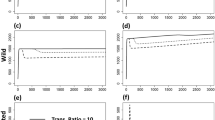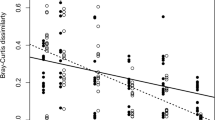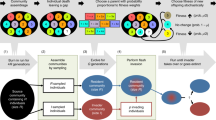Abstract
Fragmented populations possess an intriguing duplicity: even if subpopulations are reliably extinction-prone, asynchrony in local extinctions and recolonizations makes global persistence possible1,2,3,4,5,6,7,8. Migration is a double-edged sword in such cases: too little migration prevents recolonization of extinct patches, whereas too much synchronizes subpopulations, raising the likelihood of global extinction. Both edges of this proverbial sword have been explored by manipulating the rate of migration within experimental populations1,3,4,5,6,8. However, few experiments have examined how the evolutionary ecology of fragmented populations depends on the pattern of migration5. Here, we show that the migration pattern affects both coexistence and evolution within a community of bacterial hosts (Escherichia coli) and viral pathogens (T4 coliphage) distributed across a large network of subpopulations. In particular, different patterns of migration select for distinct pathogen strategies, which we term 'rapacious' and 'prudent'. These strategies define a 'tragedy of the commons'9: rapacious phage displace prudent variants for shared host resources, but prudent phage are more productive when alone. We find that prudent phage dominate when migration is spatially restricted, while rapacious phage evolve under unrestricted migration. Thus, migration pattern alone can determine whether a de novo tragedy of the commons is resolved in favour of restraint.
This is a preview of subscription content, access via your institution
Access options
Subscribe to this journal
Receive 51 print issues and online access
$199.00 per year
only $3.90 per issue
Buy this article
- Purchase on Springer Link
- Instant access to full article PDF
Prices may be subject to local taxes which are calculated during checkout



Similar content being viewed by others
References
Bonsall, M. B., French, D. R. & Hassell, M. P. Metapopulation structures affect persistence of predator–prey interactions. J. Anim. Ecol. 71, 1075–1084 (2002)
Briggs, C. J. & Hoopes, M. F. Stabilizing effects in spatial parasitoid–host and predator–prey models: a review. Theor. Popul. Biol. 65, 299–315 (2004)
Ellner, S. P. et al. Habitat structure and population persistence in an experimental community. Nature 412, 538–543 (2001)
Holyoak, M. & Lawler, S. P. Persistence of an extinction-prone predator–prey interaction through metapopulation dynamics. Ecology 77, 1867–1879 (1996)
Holyoak, M. Habitat patch arrangement and metapopulation persistence of predators and prey. Am. Nat. 156, 378–389 (2000)
Huffaker, C. B. Experimental studies on predation: dispersion factors and predator–prey oscillations. Hilgardia 27, 343–383 (1958)
Johst, K. & Schops, K. Persistence and conservation of a consumer-resource metapopulation with local overexploitation of resources. Biol. Conserv. 109, 57–65 (2003)
Thrall, P. H., Godfree, R. & Burdon, J. J. Influence of spatial structure on pathogen colonization and extinction: a test using an experimental metapopulation. Plant Pathol. 52, 350–361 (2003)
Hardin, G. The tragedy of the commons. Science 162, 1243–1248 (1968)
Holyoak, M., Leibold, M. A. & Holt, R. D. Metacommunities: Spatial Dynamics and Ecological Communities (Univ. Chicago Press, Chicago, 2005)
Antonovics, J. in Ecology, Genetics, and Evolution of Metapopulations (eds Hanski, I. & Gaggiotti, O. E.) 471–488 (Elsevier, Oxford, 2004)
Grenfell, B., Bjørnstad, O. N. & Kappey, J. Travelling waves and spatial hierarchies in measles epidemics. Nature 414, 716–723 (2001)
Keeling, M., Bjørnstad, O. N. & Grenfell, B. in Ecology, Genetics, and Evolution of Metapopulations (eds Hanski, I. & Gaggiotti, O. E.) 415–445 (Elsevier, Oxford, 2004)
Abedon, S. T., Hyman, P. & Thomas, C. Experimental examination of bacteriophage latent-period evolution as a response to bacterial availability. Appl. Environ. Microbiol. 69, 7499–7506 (2003)
Bohannan, B. J. M. & Lenski, R. E. Linking genetic change to community evolution: insights from studies of bacteria and bacteriophage. Ecol. Lett. 3, 362–377 (2000)
Lenski, R. E. & Levin, B. R. Constraints on the coevolution of bacteria and virulent phage: a model, some experiments, and predictions for natural communities. Am. Nat. 125, 585–602 (1985)
Paddison, P. et al. The roles of the bacteriophage T4 r genes in lysis inhibition and fine-structure genetics: A new perspective. Genetics 148, 1539–1550 (1998)
Keeling, M. Evolutionary trade-offs at two time-scales: competition versus persistence. Proc. R. Soc. Lond. B 267, 385–391 (2000)
Kreft, J. U. Biofilms promote altruism. Microbiology 150, 2751–2760 (2004)
Bergstrom, C. T., McElhany, P. & Real, L. A. Transmission bottlenecks as determinants of virulence in rapidly evolving pathogens. Proc. Natl Acad. Sci. USA 96, 5095–5100 (1999)
Boots, M. & Sasaki, A. 'Small worlds' and the evolution of virulence: infection occurs locally and at a distance. Proc. R. Soc. Lond. B 266, 1933–1938 (1999)
Bull, J. J., Molineux, I. J. & Rice, W. R. Selection of benevolence in a host–parasite system. Evolution 45, 875–882 (1991)
Cooper, V. S. et al. Timing of transmission and the evolution of virulence of an insect virus. Proc. R. Soc. Lond. B 269, 1161–1165 (2002)
Ebert, D. Virulence and local adaptation of a horizontally transmitted parasite. Science 265, 1084–1086 (1994)
Galvani, A. P. Epidemiology meets evolutionary ecology. Trends Ecol. Evol. 18, 132–139 (2003)
Herre, E. A. Population structure and the evolution of virulence in nematode parasites of fig wasps. Science 259, 1442–1445 (1993)
Lipsitch, M., Herre, E. A. & Nowak, M. A. Host population structure and the evolution of virulence: a 'law of diminishing returns'. Evolution 49, 743–748 (1995)
Nowak, M. A. & May, R. M. Superinfection and the evolution of parasite virulence. Proc. R. Soc. Lond. B 255, 81–89 (1994)
O'Keefe, K. J. & Antonovics, J. Playing by different rules: The evolution of virulence in sterilizing pathogens. Am. Nat. 159, 597–605 (2002)
Thrall, P. H. & Burdon, J. J. Evolution of virulence in a plant host–pathogen metapopulation. Science 299, 1735–1737 (2003)
Acknowledgements
We thank Y. Dang for help in the laboratory and the BioTechnology Resource Center at the University of Minnesota for robot access. We thank S. Abedon, C. Bergstrom, J. Bull, J. Fletcher, K. Koelle, C. Lehman, B. Levin and D. Stephens for useful feedback on this project and manuscript. This work was partially supported by an NSF grant to C.N. and an NIH grant to A.M.D. Author Contributions B.K., A.M.D. and B.J.M.B. designed the experiments. B.K. and A.M.D. worked out the robotic protocols. B.K. programmed the robot, executed the experiments, and conducted the assays. B.K. and C.N. coded and analysed the empirically calibrated and evolutionary models. B.K., C.N. and A.M.D. conducted the statistical analysis. All authors contributed to the writing of the manuscript.
Author information
Authors and Affiliations
Corresponding author
Ethics declarations
Competing interests
Reprints and permissions information is available at npg.nature.com/reprintsandpermissions. The authors declare no competing financial interests.
Supplementary information
Supplementary Methods
This file contains experimental and theoretical methods and results, giving a detailed description of the experimental methods used, presentation of experimental data, and its statistical analysis as well as the details concerning the construction and analysis of the theoretical models. (PDF 600 kb)
Rights and permissions
About this article
Cite this article
Kerr, B., Neuhauser, C., Bohannan, B. et al. Local migration promotes competitive restraint in a host–pathogen 'tragedy of the commons'. Nature 442, 75–78 (2006). https://doi.org/10.1038/nature04864
Received:
Accepted:
Issue Date:
DOI: https://doi.org/10.1038/nature04864
This article is cited by
-
Identifying Targets of Selection in Laboratory Evolution Experiments
Journal of Molecular Evolution (2023)
-
The scale of competition impacts parasite virulence evolution
Evolutionary Ecology (2023)
-
Multistep diversification in spatiotemporal bacterial-phage coevolution
Nature Communications (2022)
-
Shoaling guppies evade predation but have deadlier parasites
Nature Ecology & Evolution (2022)
-
The evolution of cheating in viruses
Nature Communications (2021)
Comments
By submitting a comment you agree to abide by our Terms and Community Guidelines. If you find something abusive or that does not comply with our terms or guidelines please flag it as inappropriate.



